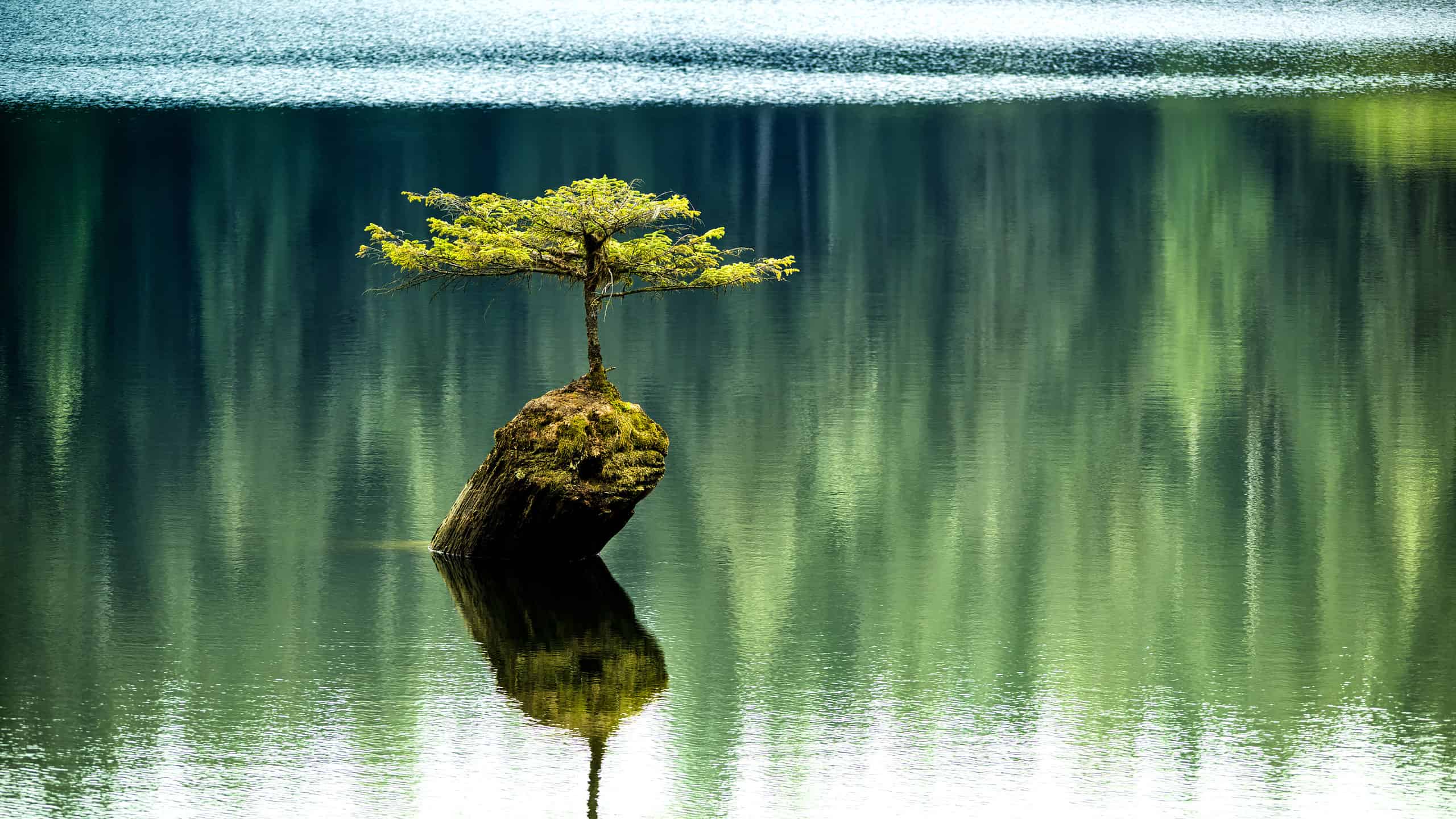Among the most common species of bonsai, besides boxwood and pine, are the fir tree specimens. These are often the species that come to mind when folks think of “bonsai” in general terms, envisioning the famous fir tree growing on a stump in Fairy Lake or the silhouettes in Japanese films.
Firs are evergreen conifers that naturally grow on strong, straight trunks with deep root systems, reaching 230 feet in height. So, it’s actually a little surprising that these trees make such excellent bonsai.
Let’s take a look at how they’ve become so synonymous with the word “bonsai” and how you can take care of one yourself.
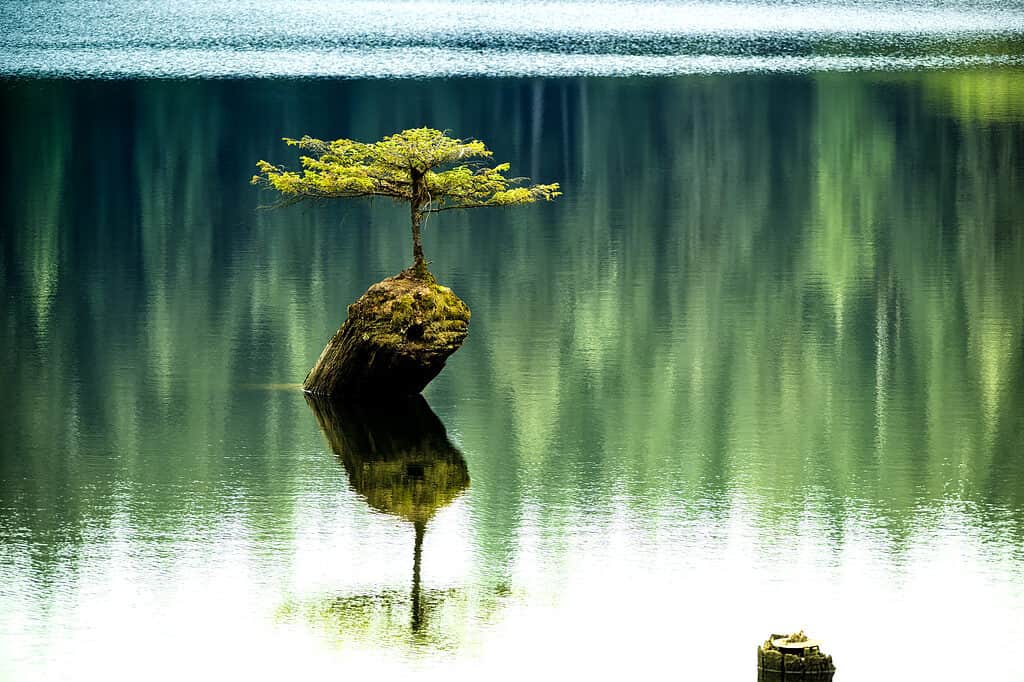
A particularly famous fir bonsai, situated in Lake Fairy.
©poemnist/Shutterstock.com
What Makes a Fir Tree Good for Bonsai?
While fir trees may be one of the most well-known bonsai, they are actually one of the more difficult species to bonsai. Unlike Ficus bonsai or Japanese Maple bonsai, the fir tree is considered appropriate for advanced bonsai enthusiasts, partially because they take a very long time to develop into bonsai and because they may be a bit challenging to grow. However, if you purchase an established fir bonsai, you may well be able to care for the tree accordingly, as long as you’re able to dedicate the appropriate time for care. If you are less advanced and do choose to do so, be sure to heavily study the art form, understand bonsai techniques, study up on fir trees as a species, and keep careful records until the care is second nature.
In other words, fir make excellent bonsai for those looking for a challenge and for those who have a lot of patience, since it takes the tree more than 10 years to begin to work in the bonsai format. If you are a beginner, you likely want to start with a simpler, faster-growing species of bonsai.
Fir Tree Classification
The fir tree is part of the Pinaceae family, going by the botanical name of Abies. The tree grows natively in North America, Central America, Europe, Asia, and some northern African countries. There are between 48 and 56 species of coniferous trees in this genus, which is closely related to the Cedrus or cedar family. Additional “cousins” in the coniferous trees include cypresses, Douglas-firs (which are not true fir), junipers, larches, kauri, hemlocks, redwoods, pines, yews, and spruces.
The name of the fir comes from the Latin term meaning “to rise,” which references the height of the common fir tree. The name originated in use by the Old Norse as fyri or the Old Danish fyr.
Fir Tree Description
There are many types and varieties of fir trees, so identification varies a bit from type to type. However, basic identification can be found in the arrange and size of the leaves (needles), shape and size of the cone, and the appearance of bract scales on the cones (are they long, or short?).
Firs can be distinguished from pines (their closest look alike) by the way the needles attach to the twigs. In fir, the needle-like leaves attach to the twig by a base that looks a bit like a suction cup. The leaves are also flattened, looking like they’ve been pressed. They also have two off-white lines on the bottom, which are formed by wax-covered stomatal bands. The top of the leaves is green and shiny, without stomata or just a few at the tips, seen as white spots. A few species of fir have dull, gray-green or blue-gray to silver leaves that are coated by waxy stomatal bands. The leaf tips are usually notches, though occasionally round or dull, or sharp and prickly, with younger plants usually displaying sharper needle points.
The cones are cylindrical and erect, between 2 and 10 inches longer on full size, mature trees. As the cones mature, they open out and release winged seeds. The cones don’t hang from the trees, but rather stand upright, looking a bit like candles on the branches of the tree. Mature cones are brown, while young cones are creamy light green to yellow, purple, or blue.

Fir bonsai easily grow well in forest bonsai styles, like this Rocky Mountain fir forest bonsai.
©Mariusz S. Jurgielewicz/Shutterstock.com
Origins and History of Fir Trees
Fir trees grow natively in North America, Central America, Europe, parts of Asia, and parts of northern Africa. They are similar to many other conifer trees and are often mistaken for each other by folks who haven’t studied the differences in detail.
Interestingly, the art of bonsai, despite being a Japanese word (bon-sai) actually originated in the Chinese empire. The art was referred to as ‘pun-sai’ with special techniques for growing dwarf trees in containers at the time. The art was only practiced by society elite using natively collected specimens. It’s not certain when fir trees became a part of the art form, per se, but it is likely to have been only among the elite using them for this purpose, based on the challenging nature of the tree as a bonsai.
Varieties of Fir Trees for Bonsai
There are a huge number of fir tree species, many of which have been used in bonsai. The species overall is challenging as bonsai, but for those ready for the long haul and intent of care, these species may be suitable options.
- Silver fir (Abies alba) – cylindrical cones, dark green needles
- Korean fir (Abies koreana) – dark green needles with chalky white portion underneath
- Dwarf Korean fir (Abies koreana ‘Compact dwarf’) – the dwarf version of the Korean fir. May be more suitable to bonsai.
- Alpine fir (Abies lasiocarpa) – gray needles
- Corkbark fir (Abies lasiocarpa var. arizonica) – silvery gray needles
- Corkbark fir ‘Compacta’ (Abies lasiocarpa var. arizonica) – dwarf variety of Corkbark fir
- Abies homolepis – dark green needles 1-inch long
- Abies firma – Japanese fir species that is more heat tolerant than other firs
- Abies concolor – drought resistant fir
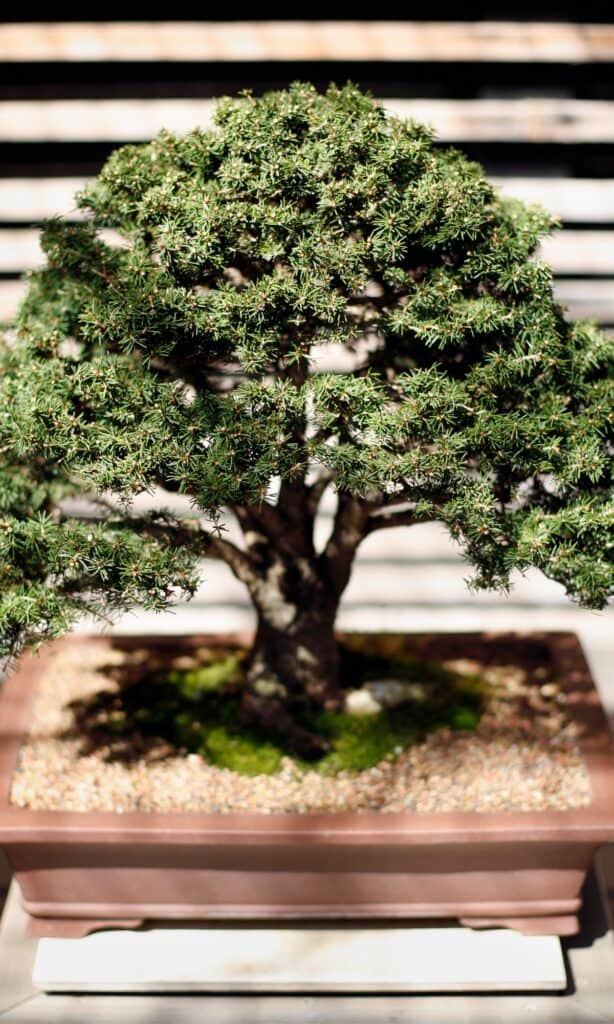
The small needles on the average fir Bonsai makes it an attractive choice.
©iStock.com/slovegrove
How to Grow Fir Bonsai Trees
The fir bonsai is a slow grower, typically taking about 10 years to reach a maturity level that is viable for creating into a bonsai. This is the time it takes for the seed to grow and be ready to cut. The specific species will determine the length of time before actual maturity is reached. Care for the bonsai from cultivation to maturity is critical for keeping the tree healthy.
Planting Location
Firs are naturally high elevation trees, meaning they tolerate direct sunlight any time of year. In hotter climates, they do need some shade, however, as they’re naturally more prone to cooler climates. Some species do better in alpine-like climates and others in warmer weather. Check the natural habitat of the species you’re planning on before planting.
And, as with all bonsai, when kept indoors, they should be kept away from drafts, air conditioners, heating or air vents, drafty doorways, and other locations that could alter the air flow in a negative way. They do need to be given plenty of light, as well, so if kept indoors, they will need a proper window (southern facing is ideal) and growing lights.
Lighting
Fir bonsai need direct light for part of the day and shade in hotter months. They generally tolerate direct light any time of day, save hot, beating sunlight in the hottest months of the year.
Temperature
The variety of fir you grow as bonsai will determine the exact temperature(s) that they will tolerate. Most North American fir thrive in growing Zones 3 to 7, with some doing well into Zone 8. When properly cared for, they can survive winters outdoors, though some growers would bring them indoors in the coldest months.

They are often mixed with other bonsai trees in varying styles in landscaping projects.
©Chamille White/Shutterstock.com
Watering
Many types of fir bonsai prefer slightly dry conditions. This means that they can tolerate a bit of dry weather or soil getting slightly dry. However, in growing season, it’s best to check the soil regularly (some suggest twice daily) to ensure the plant is healthy and thriving all season long. Most will just need watered once a day, unless they are in hot, direct sunlight. When the surface of the soil becomes dry, it needs to be watered. The climate outdoors or indoors, depending on where it is being kept, will determine the frequency needed.
Feeding
Feed the fir bonsai when new foliage appears, ideally in spring and autumn. Feed regularly through growing season – about once a month – and less frequently in cooler months. Use a bonsai fertilizer at full strength or a standard fertilizer at half strength.
Pruning, Shaping, and Wiring
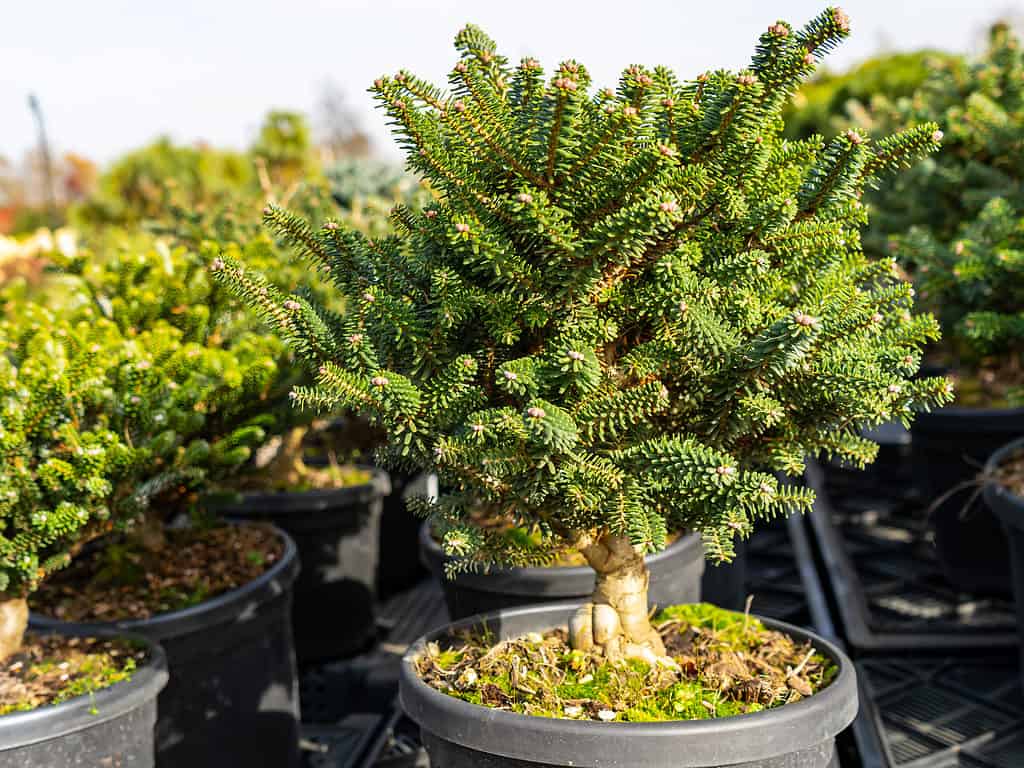
A young Koreana fir bonsai starting to develop the intriguing trunk shape of many bonsai.
©Sergey and Marina Pyataev/Shutterstock.com
Fir trees are well-suited to a number of bonsai style. They do well in group plantings or forests, multiple trunks, formal upright, informal upright, literati, slanting, and double trunk styles in most cases. The precise care you are able to provide and the species may determine otherwise, however.
Wiring for your fir bonsai should be done in autumn or late winter before new shoots start to swell out, but you should never do styling for fir in the coldest part of the winter. Detail wiring, though, may be done any time of year, with autumn and early spring or late winter as the ideal time.
When new shoots come out, pinch these back during the growing period, allowing for a second, compact growth flush. The pinching should be done when the shoots have reach about 0.5 to 1.5 inches in length. You may also choose to cut the new growth, if preferred. Make sure the growth length evens out across the tree. New terminal buds will appear within a few weeks, with back buds appearing down the shoot.
Re-potting
Since fir trees aren’t the best at pot culture, they need to become acclimated to it. This is part of why you often find fir bonsai growing in the ground in landscaping instead of in containers. They need larger pots at first (oversized), gradually shrinking the size as they mature. Re-pot your fir bonsai every 2 years, during autumn or spring, when buds appear on young trees. Add in a small amount of organic matter to the inorganic soil mix that’s slightly acidic for best results. They do well in a ratio of 1:1:1 akadama, pumice, and lava rock.
Ensure the new pot has proper drainage and make sure you leave some of the original soil as you re-pot and only slightly reduce the roots.
Common Problems of Fir Tree Bonsais

Bonsai are sometimes grown in the ground, maintained with careful oversight.
©amedeoemaja/Shutterstock.com
There are a few things that fir bonsai tend may be prone to.
Pests
Bagworm, balsam twig aphids, bark beetles, gypsy moth, scale, spider mites, and weevils are the most likely culprits, insect-wise. If any of these arise, a gentle, nontoxic pesticide will do the trick. After application, as directed, remove the dead insects manually with gloved hands. Rub down branches, needles, and branches with rubbing alcohol after.
Fungus, Canker, and Blight
Otherwise, the most likely issues you’ll have are needle cast, blight, rust, or canker of some variety. These are usually dealt with moderately easily through the use of a gentle, nontoxic fungicide. Apply as directed. Be sure that you do not tree the bonsai when the soil is wet, however, as the fungicide can damage the tree at this time.
How to Propagate Fir Tree Bonsais
Fir bonsai may be propagated through seeds, cuttings, or layering. Most commonly, folks choose to purchase established fir bonsai, however, as the tree takes 10+ years to mature into a plant suitable for starting the bonsai craft on.
Fir Tree Bonsai FAQs
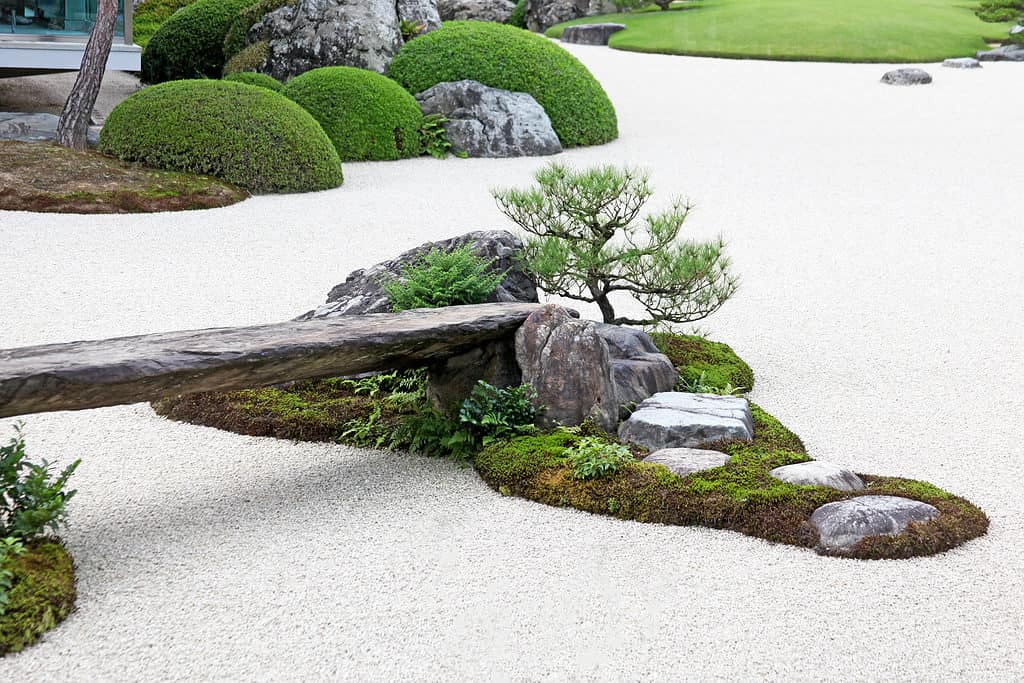
Often, bonsai are used in outdoor landscaping in Japanese gardens.
©pixbull/Shutterstock.com
As you contemplate a fir bonsai for your own, a few questions might pop up. Hopefully these FAQs will help.
How fast do fir bonsai grow?
Fir bonsai are moderately slow growers. That is, you can expect your fir to reach maturity in around 10 years. The length of time will vary, of course, depending on the variety, conditions, and level of care the bonsai receives.
Can you grow fir bonsai indoors?
If you can create the right environment for your fir bonsai, you can grow them indoors. They should be sheltered from hot midday sun yet receive enough light to grow. They need to be placed away from any air vents, air conditioners, heaters, or drafty locations, have proper circulation, and receive proper watering and feeding. If you’re able to maintain these conditions accordingly, the fir bonsai may be able to thrive as an indoor plant.
Do fir trees produce flowers?
Fir trees are not flowering plants. The beauty in these trees is the evergreen needles and eventual cones they produce.
Why are the needles on my fir bonsai turning yellow?
Needles on fir trees may well yellow in autumn and fall to the ground. However, if it’s not autumn and the needles are yellowing, the tree is likely stressed. Check for temperature (it is too cold?), signs of over watering, or nutritional deficiencies (i.e., when did you last feed it and with what?).
Can fir bonsai trees survive cold winters?
One of the particularly nice things about fir bonsais is that they are a cold weather tree. They may do well with a protective covering over them in winter during the more severe months or heavy snow fall, but technically this isn’t necessary.
Up Next:
Thank you for reading! Have some feedback for us? Contact the AZ Animals editorial team.

